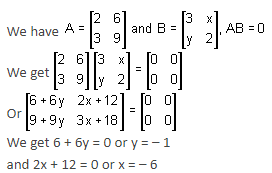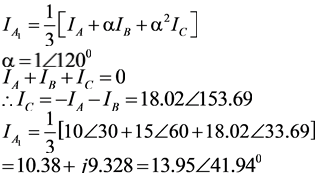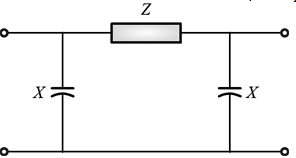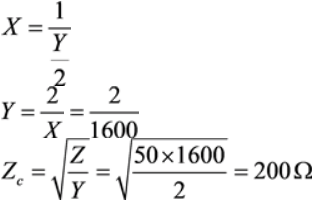All questions of Schedule & Syllabus for Electrical Engineering (EE) Exam
A 50 Hz, 3ϕ core type star-delta transformer has a line valtage ratio of 11,000/440 volts. The cross-section of the core is square with a circumscribing circle of 0.5 m diameter. If maximum flux density of 1.30 ωb/m2 then find the number of turns per phase on high voltage windings. Assume insulation occupies 8% of the total core area.
Correct answer is between '191,193'. Can you explain this answer?
A 50 Hz, 3ϕ core type star-delta transformer has a line valtage ratio of 11,000/440 volts. The cross-section of the core is square with a circumscribing circle of 0.5 m diameter. If maximum flux density of 1.30 ωb/m2 then find the number of turns per phase on high voltage windings. Assume insulation occupies 8% of the total core area.
|
|
Ravi Singh answered |
We known that diameter of the circumscribing is same as diagonal of the square.
Area of square core = l × b


∴ Net cross section area = 0.125 × 0.92 = 0.115
E.M.F/Turn = 4.44 fBA = 4.44 × 50 × 1.3 × 0.115 = 33.19
Phase turn ratio = 

∴ Number of turn per phase on high voltage side =

The area bounded by the curve y =x (3 – x)2, the x-axis and the ordinates of the maximum and minimum points of the curve is- a)2 sq. units
- b)6 sq. units
- c)8 sq. units
- d)4 sq. units
Correct answer is option 'D'. Can you explain this answer?
The area bounded by the curve y =x (3 – x)2, the x-axis and the ordinates of the maximum and minimum points of the curve is
a)
2 sq. units
b)
6 sq. units
c)
8 sq. units
d)
4 sq. units
|
|
Sanvi Kapoor answered |
y = x(3 – x)2
 −x.2(3−x) + (3−x)2 = 3(x2−4x+3) = 0
−x.2(3−x) + (3−x)2 = 3(x2−4x+3) = 0(x - 3) (x – 1) = 0 ⇒ x = 3, x = 1



When a four digit number is divided by 65, it leaves a remainder of 29. If the same number is divided by 13, the remainder would be______
Correct answer is '3'. Can you explain this answer?
When a four digit number is divided by 65, it leaves a remainder of 29. If the same number is divided by 13, the remainder would be______
|
|
Mahesh Singh answered |
Let number is N
N = 65 k +29
 ∴ Remainder = 3
∴ Remainder = 3 A 230 V, 50Hz , one pulse SCR controlled converter is triggered at a firing angle of 400 and the load current extinguishes at an angle of 2100 . For a load of R=5Ω and L=2mH. The circuit-turn off time and average output voltage is- a)8.33μsec,84.84 V
- b)8.44m sec,83.38 V
- c)8.33 m sec 84.48 V
- d)8.33 sec, 84.48 V
Correct answer is option 'C'. Can you explain this answer?
A 230 V, 50Hz , one pulse SCR controlled converter is triggered at a firing angle of 400 and the load current extinguishes at an angle of 2100 . For a load of R=5Ω and L=2mH. The circuit-turn off time and average output voltage is
a)
8.33μsec,84.84 V
b)
8.44m sec,83.38 V
c)
8.33 m sec 84.48 V
d)
8.33 sec, 84.48 V
|
|
Pallavi Nair answered |
Given parameters:
- Voltage (V) = 230 V
- Frequency (f) = 50 Hz
- Firing angle (α) = 40°
- Extinction angle (β) = 210°
- Load resistance (R) = 5 Ω
- Load inductance (L) = 2 mH
To find:
- Circuit-turn off time
- Average output voltage
Solution:
1. Calculation of circuit-turn off time:
- Circuit-turn off time (tq) can be calculated using the following formula:
tq = (π - β + α) / (2πf)
- Substituting the given values in the formula, we get:
tq = (π - 210° + 40°) / (2π x 50 Hz)
tq = 8.33 ms
- Therefore, the circuit-turn off time is 8.33 ms.
2. Calculation of average output voltage:
- Average output voltage (Vo) can be calculated using the following formula:
Vo = (2V / π) x (cos α - cos β) - (2IR)
- Substituting the given values in the formula, we get:
Vo = (2 x 230 V / π) x (cos 40° - cos 210°) - (2 x 5 Ω x I)
Vo = 84.48 V - 10 I
- To find the value of I, we need to use the fact that the load current extinguishes at an angle of β = 210°. At this point, the load current is given by:
iL = Im sin (ωt + φ)
where Im = V / √(R^2 + ω^2L^2) = 45.67 A (rms value)
ω = 2πf = 314.16 rad/s
φ = tan^-1 (ωL / R) = 0.79°
- At β = 210°, we have:
iL = Im sin (ωβ + φ) = -36.64 A (rms value, negative sign indicates that the current is flowing in the opposite direction)
- Therefore, the value of I can be calculated as:
I = iL / √2 = -25.92 A (peak value, negative sign indicates that the current is flowing in the opposite direction)
- Substituting the value of I in the equation for Vo, we get:
Vo = 84.48 V - 10 x (-25.92 A)
Vo = 83.38 V
- Therefore, the average output voltage is 83.38 V.
Answer:
The circuit-turn off time is 8.33 ms and the average output voltage is 84.48 V. Therefore, the correct answer is option (c) 8.33 ms, 84.48 V.
- Voltage (V) = 230 V
- Frequency (f) = 50 Hz
- Firing angle (α) = 40°
- Extinction angle (β) = 210°
- Load resistance (R) = 5 Ω
- Load inductance (L) = 2 mH
To find:
- Circuit-turn off time
- Average output voltage
Solution:
1. Calculation of circuit-turn off time:
- Circuit-turn off time (tq) can be calculated using the following formula:
tq = (π - β + α) / (2πf)
- Substituting the given values in the formula, we get:
tq = (π - 210° + 40°) / (2π x 50 Hz)
tq = 8.33 ms
- Therefore, the circuit-turn off time is 8.33 ms.
2. Calculation of average output voltage:
- Average output voltage (Vo) can be calculated using the following formula:
Vo = (2V / π) x (cos α - cos β) - (2IR)
- Substituting the given values in the formula, we get:
Vo = (2 x 230 V / π) x (cos 40° - cos 210°) - (2 x 5 Ω x I)
Vo = 84.48 V - 10 I
- To find the value of I, we need to use the fact that the load current extinguishes at an angle of β = 210°. At this point, the load current is given by:
iL = Im sin (ωt + φ)
where Im = V / √(R^2 + ω^2L^2) = 45.67 A (rms value)
ω = 2πf = 314.16 rad/s
φ = tan^-1 (ωL / R) = 0.79°
- At β = 210°, we have:
iL = Im sin (ωβ + φ) = -36.64 A (rms value, negative sign indicates that the current is flowing in the opposite direction)
- Therefore, the value of I can be calculated as:
I = iL / √2 = -25.92 A (peak value, negative sign indicates that the current is flowing in the opposite direction)
- Substituting the value of I in the equation for Vo, we get:
Vo = 84.48 V - 10 x (-25.92 A)
Vo = 83.38 V
- Therefore, the average output voltage is 83.38 V.
Answer:
The circuit-turn off time is 8.33 ms and the average output voltage is 84.48 V. Therefore, the correct answer is option (c) 8.33 ms, 84.48 V.
In a group, there are 32 people. All of them know at least one of the three languages : Hindi, English and Marathi. 25 people know Hindi, 20 know English and 15 know Marathi. 15 people know Hindi and English. 5 people know English and Marathi. If 3 people know all the three languages, then how many people know Hindi and Marathi?- a)9
- b)8
- c)13
- d)11
Correct answer is option 'D'. Can you explain this answer?
In a group, there are 32 people. All of them know at least one of the three languages : Hindi, English and Marathi. 25 people know Hindi, 20 know English and 15 know Marathi. 15 people know Hindi and English. 5 people know English and Marathi. If 3 people know all the three languages, then how many people know Hindi and Marathi?
a)
9
b)
8
c)
13
d)
11
|
|
Mani Paramasivan answered |
Option b is correct
32=(25+20+15)-(15+5+(x+3))+3
32=60-23-x+3
32=40-x
x=8
32=(25+20+15)-(15+5+(x+3))+3
32=60-23-x+3
32=40-x
x=8
For the chopper circuit shown in the sure duty ratio is 0.3. What is the chopping frequency to limit the amplitude of load current excursion to 8 A? (Where Vdc= 400 V) (Answer up to two decimal places)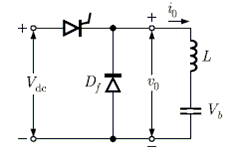 Correct answer is '209.79'. Can you explain this answer?
Correct answer is '209.79'. Can you explain this answer?
For the chopper circuit shown in the sure duty ratio is 0.3. What is the chopping frequency to limit the amplitude of load current excursion to 8 A? (Where Vdc= 400 V) (Answer up to two decimal places)


|
EduRev GATE answered |
Circuit wave forms are shown as below
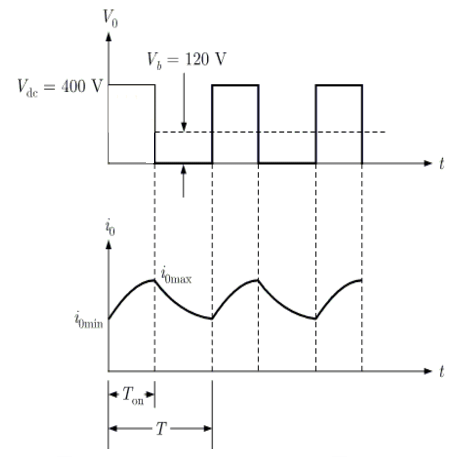
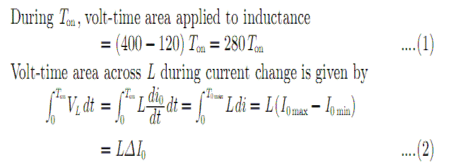
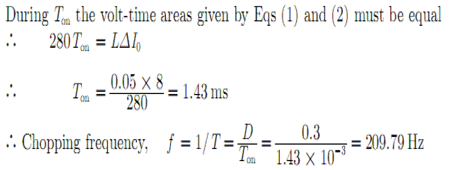
The meter constant of 5 A, 220 V, dc watthour meter is 3275 revolution per kwh. Calculate the speed of the disc at full load. In a test at half load the meter takes 59.5 sec to complete 30 revolutions. Calculate the error of the metre.- a)0.77%
- b)1.77%
- c)0.1%
- d)2.77%
Correct answer is option 'A'. Can you explain this answer?
The meter constant of 5 A, 220 V, dc watthour meter is 3275 revolution per kwh. Calculate the speed of the disc at full load. In a test at half load the meter takes 59.5 sec to complete 30 revolutions. Calculate the error of the metre.
a)
0.77%
b)
1.77%
c)
0.1%
d)
2.77%
|
|
Rahul Banerjee answered |
Energy consumed in one miute

= 0.01833 kwh
∴ Revolution in one minute = E × K = 0.01833 × 3275 = 60.04 rpm
∴ Speed of disc = 60.04 RPM = 1 r.p.s
At half load
 = 2.5A,t = 59.5sec
= 2.5A,t = 59.5secEt = VIcosϕ×t = 2220×2.5×1×59.5 = 0.00909027kwh
N = 30 revolutions


The rotor resistance and standstill reactance of a 3-phase induction motor are respectively 0.018Ω and 0.08 Ω per phase, normal slip at full load is 4%. The percentage reduction in stator voltage to develop full-load torque at half of full-load speed is.- a)31.2%
- b)41.2%
- c)51.2%
- d)21.2%
Correct answer is option 'A'. Can you explain this answer?
The rotor resistance and standstill reactance of a 3-phase induction motor are respectively 0.018Ω and 0.08 Ω per phase, normal slip at full load is 4%. The percentage reduction in stator voltage to develop full-load torque at half of full-load speed is.
a)
31.2%
b)
41.2%
c)
51.2%
d)
21.2%

|
Pioneer Academy answered |


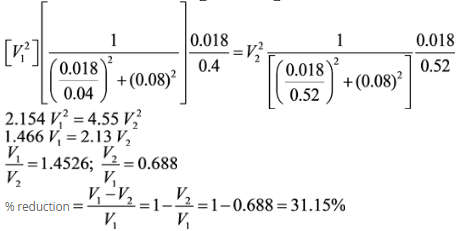
A random variable ‘X’ is uniformly distributed in the interval [-2, 3] . Another random variable Y is related to random variable X as Y =2X+3. The value of variance of Y is- a)5.21
- b)6.33
- c)8.33
- d)10.51
Correct answer is option 'C'. Can you explain this answer?
A random variable ‘X’ is uniformly distributed in the interval [-2, 3] . Another random variable Y is related to random variable X as Y =2X+3. The value of variance of Y is
a)
5.21
b)
6.33
c)
8.33
d)
10.51
|
|
Zoya Sharma answered |
Given that random variable is uniformly distributed in the interval[-2, 3] .
PDF of X is as shown below,
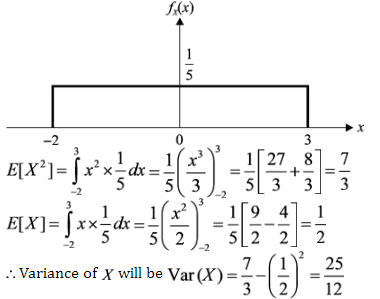
Given, Y=2X+3
Var (Y)= Var (2X)+Var(3)
Var (Y) =22 Var (X)+0
Var (Y) = 4Var (X)
Var (Y) =4*25/12=8.33
If x+y = 45.6, then the value of (x-25.2)3 + (y-20.4)3 is- a)0
- b)1
- c)4
- d)3
Correct answer is option 'A'. Can you explain this answer?
If x+y = 45.6, then the value of (x-25.2)3 + (y-20.4)3 is
a)
0
b)
1
c)
4
d)
3
|
|
Yash Patel answered |
Given
x+y = 45.6
Method 1 :
We can write the above given equation as
x + y = 25.2 + 20.4
So, (x - 25.2) + (y - 20.4) = 0…...(i)
Cubing both the sides and using the formula
We have,(x - 25.2)3 + (y - 20.4)3 + 3(x - 25.2)(y - 20.4){x - 25.2) + (y - 20.4)} = 0
Substituting value from (i), we have
(x - 25.2)3 + (y - 20.4)3 + 0 = 0
(x - 25.2)3 + (y - 20.4)3 = 0
Hence, the value of is(x - 25.2)3 + (y - 20.4)3 is 0
Method 2 :
x+y = 45.6
To find(x - 25.2)3 + (y - 20.4)3
Putting value of x from equation (i),
(20.4 - y)3 + (y - 20.4)3
= (y - 20.4)3 - (y - 20.4)3 = 0
Thus, the value of(x - 25.2)3 + (y - 20.4)3 is 0.
Voltage series feedback (also called series-shunt feedback) results in- a)increase in both input and output impedances
- b)decrease in both input and output impedances
- c)increase in input impedance and decrease in output impedance
- d)decrease in input impedance and increase in output impedance
Correct answer is option 'C'. Can you explain this answer?
Voltage series feedback (also called series-shunt feedback) results in
a)
increase in both input and output impedances
b)
decrease in both input and output impedances
c)
increase in input impedance and decrease in output impedance
d)
decrease in input impedance and increase in output impedance
|
|
Pooja Patel answered |
In voltage series feed back amplifier, input impedance increases by factor (1+Aβ) and output impedance decreases by the factor (1 + Aβ)

Choose the appropriate word/phrase to complete the sentence :The _________ of skirt made it easy for the children to understand that Aunt Polly was in the corridor.- a)Blowing
- b)Swishing
- c)Flying
- d)Rubbing
Correct answer is option 'B'. Can you explain this answer?
Choose the appropriate word/phrase to complete the sentence :
The _________ of skirt made it easy for the children to understand that Aunt Polly was in the corridor.
a)
Blowing
b)
Swishing
c)
Flying
d)
Rubbing
|
|
Mahesh Datta answered |
The appropriate word to complete the sentence is "swishing".
Explanation:
The word "swishing" means to move with a soft rustling or hissing sound. In the given sentence, the context suggests that Aunt Polly's skirt is making a sound as she walks in the corridor, and this sound helps the children to understand that she is present there.
Here is a breakdown of the options and why "swishing" is the correct choice:
- Blowing: This option does not fit the context because blowing refers to the movement of air or wind, and it does not convey the idea of a sound caused by Aunt Polly's skirt.
- Swishing: This option is the correct choice because it describes the sound made by Aunt Polly's skirt as she moves in the corridor. The word "swishing" suggests a soft rustling or hissing sound, which is appropriate for the context.
- Flying: This option does not fit the context because flying refers to the movement of objects through the air, and it does not convey the idea of a sound caused by Aunt Polly's skirt.
- Rubbing: This option does not fit the context because rubbing refers to the action of moving something back and forth against a surface, and it does not convey the idea of a sound caused by Aunt Polly's skirt.
Therefore, the correct word to complete the sentence is "swishing", as it accurately describes the sound made by Aunt Polly's skirt as she walks in the corridor.
Explanation:
The word "swishing" means to move with a soft rustling or hissing sound. In the given sentence, the context suggests that Aunt Polly's skirt is making a sound as she walks in the corridor, and this sound helps the children to understand that she is present there.
Here is a breakdown of the options and why "swishing" is the correct choice:
- Blowing: This option does not fit the context because blowing refers to the movement of air or wind, and it does not convey the idea of a sound caused by Aunt Polly's skirt.
- Swishing: This option is the correct choice because it describes the sound made by Aunt Polly's skirt as she moves in the corridor. The word "swishing" suggests a soft rustling or hissing sound, which is appropriate for the context.
- Flying: This option does not fit the context because flying refers to the movement of objects through the air, and it does not convey the idea of a sound caused by Aunt Polly's skirt.
- Rubbing: This option does not fit the context because rubbing refers to the action of moving something back and forth against a surface, and it does not convey the idea of a sound caused by Aunt Polly's skirt.
Therefore, the correct word to complete the sentence is "swishing", as it accurately describes the sound made by Aunt Polly's skirt as she walks in the corridor.
A high impedance probe with 9MΩ resistance and 4 pF capacitance is connected to an oscilloscope with an input resistance of 1MΩ. If the effective capacitance is now decreased to 3.6 pF when the probe was connected, the capacitance of the oscilloscope alone in Pico-Farads is _____.
Correct answer is '36'. Can you explain this answer?
A high impedance probe with 9MΩ resistance and 4 pF capacitance is connected to an oscilloscope with an input resistance of 1MΩ. If the effective capacitance is now decreased to 3.6 pF when the probe was connected, the capacitance of the oscilloscope alone in Pico-Farads is _____.
|
|
Ravi Singh answered |
Given
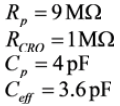
Now, the probe-oscilloscope step can be represented as,
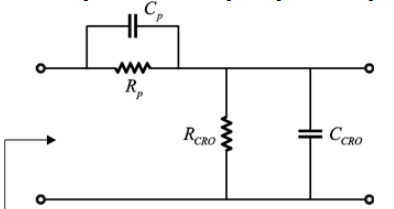

The standard deviations of linear dimensions P and Q are 3?m and 4?m, respectively. When assembled, the standard deviation (in?m) of the resulting linear dimension (P + Q) is _________. (Answer up to the nearest integer)
Correct answer is '5'. Can you explain this answer?
The standard deviations of linear dimensions P and Q are 3?m and 4?m, respectively. When assembled, the standard deviation (in?m) of the resulting linear dimension (P + Q) is _________. (Answer up to the nearest integer)
|
|
Pooja Patel answered |
Given
Standard deviation of P = 3?m Variance of P = 9?m
Standard deviation of Q = 4?m Variance of Q = 16?m
Variance of P + Q = Var(P + Q) = Variance P + Variance Q = 9 + 16 = 25
Standard deviation of

A radial transmission system with the ratings and reactances of the various components is shown in the following figure. A load of 60 MW at 0.9 power factor lagging is fed from the 66 kV substation which is to be maintained at 60 kV. The terminal voltage (line) of the synchronous machine (M) is __________kV. (Answer up to the nearest integer)
Correct answer is '12'. Can you explain this answer?
A radial transmission system with the ratings and reactances of the various components is shown in the following figure. A load of 60 MW at 0.9 power factor lagging is fed from the 66 kV substation which is to be maintained at 60 kV. The terminal voltage (line) of the synchronous machine (M) is __________kV. (Answer up to the nearest integer)


|
Cstoppers Instructors answered |
Choose 100 MVA base and represent all quantities in pu, we get
Reactance of the first transformer XT1 = 0.1 pu
Reactance of the second transformer XT2 = 0.08 pu
Reactance of transmission line XL = 150 x 100/(200)2 = 0.31 pu
Load in pu 60/100 = 0.6 pu MW;0.9 pf lagging
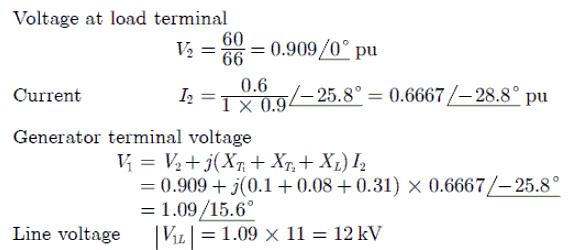
Generator terminal voltage

Two sinusoidal voltage signals of equal frequency are applied to the vertical and horizontal deflection plates of a CRO. The output observed on the screen is shown in the following figure. The phase difference (in degrees) between the applied signals is (Answer up to one decimal place)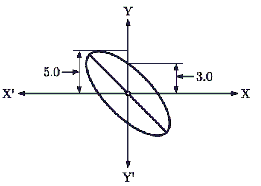
Correct answer is '143.1'. Can you explain this answer?
Two sinusoidal voltage signals of equal frequency are applied to the vertical and horizontal deflection plates of a CRO. The output observed on the screen is shown in the following figure. The phase difference (in degrees) between the applied signals is (Answer up to one decimal place)


|
Pioneer Academy answered |
Pattern observed on the screen is an ellipse. So, an phase angle

We can see from the figure that ellipse is in second and fourth quadrants so the valid value of phase angle is 143.10 .
The power dissipated in 2kΩ resistance is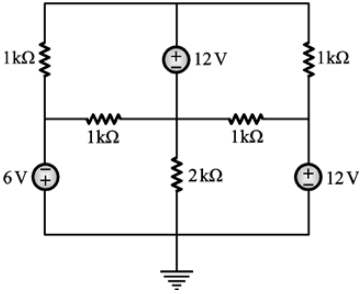
- a)0.55 mW
- b)3.55 mW
- c)2.68 mW
- d)0.78 mW
Correct answer is option 'B'. Can you explain this answer?
The power dissipated in 2kΩ resistance is

a)
0.55 mW
b)
3.55 mW
c)
2.68 mW
d)
0.78 mW

|
Pioneer Academy answered |
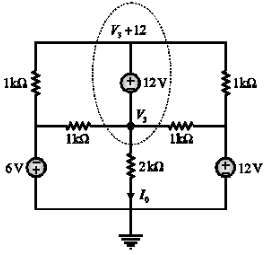
The KCL equation for the supernode is,
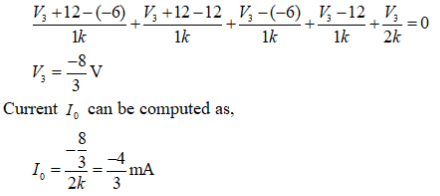
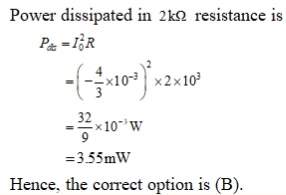
In the circuit below, two series connected capacitors of 3∝F and 6∝F having initial voltage of 4 V and 6 V are connected across a black box at t = 0.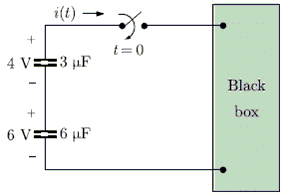 For t ≥ 0, it is given that i (t) = 20e−tμA.The total energy delivered (in μJ) to the black box will be (Answer up to the nearest integer)
For t ≥ 0, it is given that i (t) = 20e−tμA.The total energy delivered (in μJ) to the black box will be (Answer up to the nearest integer)
Correct answer is '100'. Can you explain this answer?
In the circuit below, two series connected capacitors of 3∝F and 6∝F having initial voltage of 4 V and 6 V are connected across a black box at t = 0.

For t ≥ 0, it is given that i (t) = 20e−tμA.
The total energy delivered (in μJ) to the black box will be (Answer up to the nearest integer)

|
Cstoppers Instructors answered |
Combining the series connected capacitor,
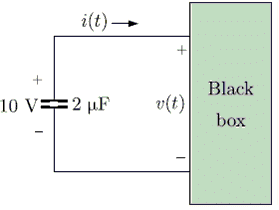
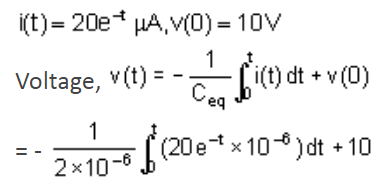

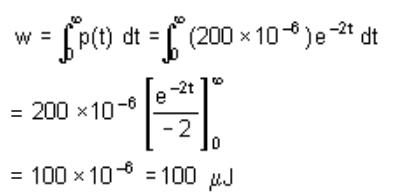 ,
,




Energy delivered to the black box in the interval 0 < t="" />< />
 ,
, What memory address range is NOT represented by chip # 1 and chip # 2 in the figure, where A0 to A15 are the address lines and CS means chip select?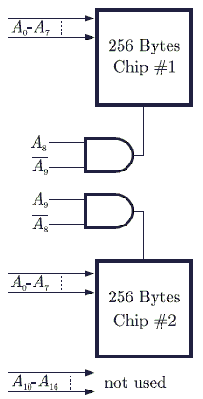
- a)0100 - 02FF
- b)1500 - 16FF
- c)F900 - FAFF
- d)F800 - F9FF
Correct answer is option 'D'. Can you explain this answer?
What memory address range is NOT represented by chip # 1 and chip # 2 in the figure, where A0 to A15 are the address lines and CS means chip select?

a)
0100 - 02FF
b)
1500 - 16FF
c)
F900 - FAFF
d)
F800 - F9FF
|
|
Ravi Singh answered |
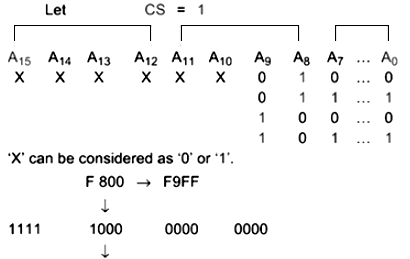
In this address A8 and A9 both are in '0' Logic, so both chips will not be selected, so this address will not select any chip.
Sphere of radius a with a uniform charge density ρvC/m3 shall have electric flux density at r = a, equal to- a)

- b)

- c)

- d)

Correct answer is option 'A'. Can you explain this answer?
Sphere of radius a with a uniform charge density ρvC/m3 shall have electric flux density at r = a, equal to
a)

b)

c)

d)


|
Naroj Boda answered |
Given: Charge density = ρv C/m3
By Gauss’s law,

Since D is radially outward and constant throughout the spherical surface.
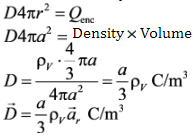
The minimum number of 2-input NOR gates required to implementY = ACE + AFC + ADE + ADF + BCE + BDF + BCF+BDE is _____. (Correct upto nearest integer)
Correct answer is '6'. Can you explain this answer?
The minimum number of 2-input NOR gates required to implement
Y = ACE + AFC + ADE + ADF + BCE + BDF + BCF+BDE is _____. (Correct upto nearest integer)
|
|
Pooja Patel answered |
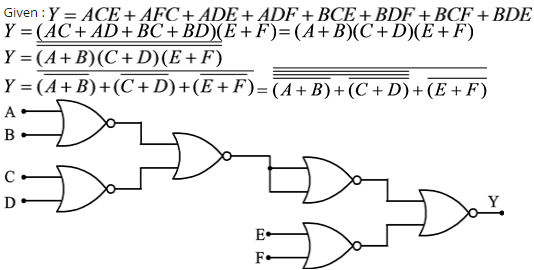
Figure
Hence, the total number of 2-input NOR gates are 6.
A coin tossed thrice. Let X be the event that head occurs in each of the first two tosses. Let Y be the event that a tail occurs on the third toss. Let Z be the event that two tails occurs in three tosses.Based on the above information, which one of the following statements is NOT TRUE?- a)X and Y are not independent
- b)Y and Z are dependent
- c)Y and Z are independent
- d)X and Z are independent
Correct answer is option 'C'. Can you explain this answer?
A coin tossed thrice. Let X be the event that head occurs in each of the first two tosses. Let Y be the event that a tail occurs on the third toss. Let Z be the event that two tails occurs in three tosses.
Based on the above information, which one of the following statements is NOT TRUE?
a)
X and Y are not independent
b)
Y and Z are dependent
c)
Y and Z are independent
d)
X and Z are independent
|
|
Pooja Patel answered |
X = { HHH, HHT}
Y = { HHT, HTT, THT, TTT}
Z = { HTT, THT, TTH, TTT}
X and Y are dependent.
Y and Z are dependent.
X and Z are independent.
So, option (3) is not true.
The rectification efficiency of a single phase Half Wave Controlled Rectifier having a resistive load and the delay angle of π/2 is _______%. (correct upto two decimal places
Correct answer is '20.23'. Can you explain this answer?
The rectification efficiency of a single phase Half Wave Controlled Rectifier having a resistive load and the delay angle of π/2 is _______%. (correct upto two decimal places
|
|
Yash Patel answered |
Given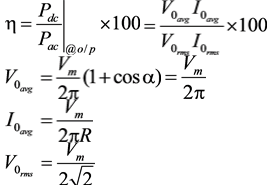 ,
,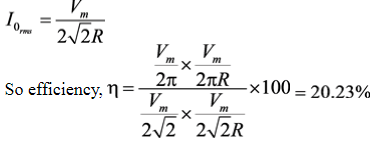
Single phase Half Wave Controlled Rectifier
Resistive load
∝= π/2
Rectification efficiency 

 ,
,
If the supply frequency of a 6-pole synchronous motor is changed from 50 Hz to 60 Hz, then the speed regulation of a synchronous motor will be- a)zero
- b)5%
- c)17%
- d)20%
Correct answer is option 'A'. Can you explain this answer?
If the supply frequency of a 6-pole synchronous motor is changed from 50 Hz to 60 Hz, then the speed regulation of a synchronous motor will be
a)
zero
b)
5%
c)
17%
d)
20%
|
|
Pooja Patel answered |
Speed regulation is defined as the change in speed of motor from no load to full load. A synchronous motor always runs on synchronous speed. For all frequencies, the speed of a synchronous motor remains same from no load to full load. Hence, for all supply frequencies, the speed regulation of a synchronous motor is always zero.
Answer the following question based on the following information. The number of Indians who view Sony is 4,320,000. What is the number of people viewing DD-II?
The number of Indians who view Sony is 4,320,000. What is the number of people viewing DD-II?- a)10,080,000
- b)9,660,000
- c)10,164,000
- d)None of these
Correct answer is option 'A'. Can you explain this answer?
Answer the following question based on the following information.

The number of Indians who view Sony is 4,320,000. What is the number of people viewing DD-II?
a)
10,080,000
b)
9,660,000
c)
10,164,000
d)
None of these

|
Pioneer Academy answered |
Percentage of those viewing Sony = 6%

Percentage of those viewing DD-II = 14 %

∴ Number of DD-II viewers

A 4 pole induction machine is working as an induction generator. The generator supply frequency is 60 Hz. The rotor current frequency is 5 Hz. The mechanical speed of the rotor in RPM is- a)1350
- b)1650
- c)1950
- d)2250
Correct answer is option 'C'. Can you explain this answer?
A 4 pole induction machine is working as an induction generator. The generator supply frequency is 60 Hz. The rotor current frequency is 5 Hz. The mechanical speed of the rotor in RPM is
a)
1350
b)
1650
c)
1950
d)
2250
|
|
Mahesh Datta answered |
Theory:
An induction generator is a type of asynchronous generator, which is primarily used in renewable energy systems. It works on the principle of electromagnetic induction. The stator windings of the induction machine are connected to the grid and are supplied with a constant frequency. The rotor windings of the machine are shorted and rotate due to the mechanical input. This rotation induces voltages in the stator windings, which are then fed back into the grid as electrical power.
Given:
- Generator supply frequency (f) = 60 Hz
- Rotor current frequency (fr) = 5 Hz
Formula:
The mechanical speed of the rotor (N) can be calculated using the formula:
N = (120 * fr) / p
Where:
- N = rotor speed in RPM
- fr = rotor current frequency in Hz
- p = number of poles
Calculation:
Given that the number of poles (p) is 4, we can substitute the values in the formula to find the rotor speed.
N = (120 * 5) / 4
N = 1500 RPM
Therefore, the mechanical speed of the rotor is 1500 RPM.
Explanation:
The mechanical speed of the rotor depends on the number of poles and the rotor current frequency. In this case, the number of poles is 4 and the rotor current frequency is 5 Hz. By substituting these values into the formula, we find that the mechanical speed of the rotor is 1500 RPM. Therefore, the correct answer is option 'C' (1950).
An induction generator is a type of asynchronous generator, which is primarily used in renewable energy systems. It works on the principle of electromagnetic induction. The stator windings of the induction machine are connected to the grid and are supplied with a constant frequency. The rotor windings of the machine are shorted and rotate due to the mechanical input. This rotation induces voltages in the stator windings, which are then fed back into the grid as electrical power.
Given:
- Generator supply frequency (f) = 60 Hz
- Rotor current frequency (fr) = 5 Hz
Formula:
The mechanical speed of the rotor (N) can be calculated using the formula:
N = (120 * fr) / p
Where:
- N = rotor speed in RPM
- fr = rotor current frequency in Hz
- p = number of poles
Calculation:
Given that the number of poles (p) is 4, we can substitute the values in the formula to find the rotor speed.
N = (120 * 5) / 4
N = 1500 RPM
Therefore, the mechanical speed of the rotor is 1500 RPM.
Explanation:
The mechanical speed of the rotor depends on the number of poles and the rotor current frequency. In this case, the number of poles is 4 and the rotor current frequency is 5 Hz. By substituting these values into the formula, we find that the mechanical speed of the rotor is 1500 RPM. Therefore, the correct answer is option 'C' (1950).
The current coil of a dynamometer wattmeter is connected to a 24V dc source in series with  resistor. The potential circuit is connected through an ideal half wave rectifier in series with 50Hz source of 100V. The inductance of pressure circuit and current coil resistance are negligible. The reading of wattmeter in watts is ______________. (Correct upto nearest integer)
resistor. The potential circuit is connected through an ideal half wave rectifier in series with 50Hz source of 100V. The inductance of pressure circuit and current coil resistance are negligible. The reading of wattmeter in watts is ______________. (Correct upto nearest integer)
Correct answer is '180'. Can you explain this answer?
The current coil of a dynamometer wattmeter is connected to a 24V dc source in series with  resistor. The potential circuit is connected through an ideal half wave rectifier in series with 50Hz source of 100V. The inductance of pressure circuit and current coil resistance are negligible. The reading of wattmeter in watts is ______________. (Correct upto nearest integer)
resistor. The potential circuit is connected through an ideal half wave rectifier in series with 50Hz source of 100V. The inductance of pressure circuit and current coil resistance are negligible. The reading of wattmeter in watts is ______________. (Correct upto nearest integer)
 resistor. The potential circuit is connected through an ideal half wave rectifier in series with 50Hz source of 100V. The inductance of pressure circuit and current coil resistance are negligible. The reading of wattmeter in watts is ______________. (Correct upto nearest integer)
resistor. The potential circuit is connected through an ideal half wave rectifier in series with 50Hz source of 100V. The inductance of pressure circuit and current coil resistance are negligible. The reading of wattmeter in watts is ______________. (Correct upto nearest integer)|
|
Pooja Patel answered |

The pressure coil is energized by an ideal half wave rectifier therefore, the pressure coil carrier current during one half cycle and in the other half cycle there is no current in it. This means that there is a deflecting torque on the meter during one half cycle.
Reading of the wattmeter = Average power over a cycle

The area bounded by the curves y2 = 9x, x − y + 2 = 0 is (Answer up to one decimal place)
Correct answer is '0.5'. Can you explain this answer?
The area bounded by the curves y2 = 9x, x − y + 2 = 0 is (Answer up to one decimal place)
|
|
Pooja Patel answered |
The equation of the given curves are,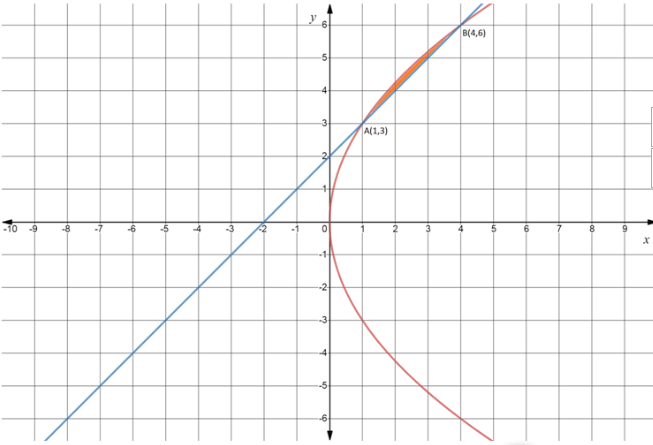
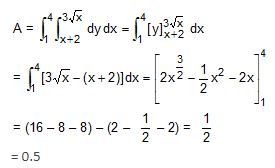
y2 = 9x ... (i)
x – y + 2 = 0 .... (ii)
The curves (i) and (ii) intersect at A(1, 3) and B(4, 6) as shown in below figure.


A generator with the frequency-power characteristics shown in figure A is supplying a load. Now a second load is to be connected in parallel with the first one as shown in figure B. Load 1 consumes a real power of 1000 kW at 0.8 PF lagging, while load 2 consumes a real power of 800 kW at 0.707 PF lagging. The operating frequencies of the system before and after the second load is connected are respectively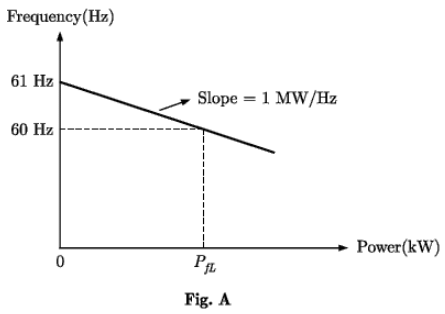
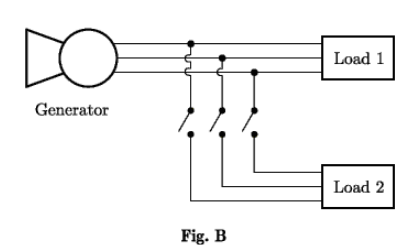
- a)60 Hz, 61 Hz
- b)61 Hz, 60 Hz
- c)60 Hz, 60 Hz
- d)60 Hz, 59.2 Hz
Correct answer is option 'D'. Can you explain this answer?
A generator with the frequency-power characteristics shown in figure A is supplying a load. Now a second load is to be connected in parallel with the first one as shown in figure B. Load 1 consumes a real power of 1000 kW at 0.8 PF lagging, while load 2 consumes a real power of 800 kW at 0.707 PF lagging. The operating frequencies of the system before and after the second load is connected are respectively


a)
60 Hz, 61 Hz
b)
61 Hz, 60 Hz
c)
60 Hz, 60 Hz
d)
60 Hz, 59.2 Hz

|
Pioneer Academy answered |

After the second load is connected,

Before the second load is connected system frequency is
It is desired to measure the parameters of 230V/115V, 2kVA, single phase transformer. The following wattmeters are available in a laboratory.W1: 250 V, 10 A, Low Power FactorW2: 250 V, 5 A, Low Power FactorW3: 150 V, 10 A, High Power FactorW4: 150 V, 5 A, High Power FactorThe wattmeters used in open circuit test and short circuit test of the transformer will respectively be- a)W1 and W2
- b)W2and W4
- c)W1 and W4
- d)W2 and W3
Correct answer is option 'D'. Can you explain this answer?
It is desired to measure the parameters of 230V/115V, 2kVA, single phase transformer. The following wattmeters are available in a laboratory.
W1: 250 V, 10 A, Low Power Factor
W2: 250 V, 5 A, Low Power Factor
W3: 150 V, 10 A, High Power Factor
W4: 150 V, 5 A, High Power Factor
The wattmeters used in open circuit test and short circuit test of the transformer will respectively be
a)
W1 and W2
b)
W2and W4
c)
W1 and W4
d)
W2 and W3
|
|
Pankaj Mehta answered |
Measurement of Transformer Parameters Using Wattmeters
Open Circuit Test:
- Wattmeter W2 and W3 are not suitable as they have low power factor and high power factor respectively which will not give accurate readings for open circuit test.
- Wattmeter W1 can be used as it can measure up to 250V and 10A, which is suitable for measuring the voltage and current of the high voltage winding of the transformer during open circuit test.
- Wattmeter W4 can also be used as it can measure up to 150V and 5A, which is suitable for measuring the voltage and current of the low voltage winding of the transformer during open circuit test.
- Therefore, the wattmeters used in open circuit test of the transformer will be W1 and W4.
Short Circuit Test:
- Wattmeter W1 is not suitable for short circuit test as it can measure up to 250V and 10A, which is too high for measuring the voltage and current of the low voltage winding of the transformer during short circuit test.
- Wattmeter W4 is also not suitable for short circuit test as it can measure up to 150V and 5A, which is too low for measuring the voltage and current of the high voltage winding of the transformer during short circuit test.
- Wattmeter W2 can be used as it can measure up to 250V and 5A, which is suitable for measuring the voltage and current of the high voltage winding of the transformer during short circuit test.
- Wattmeter W3 can also be used as it can measure up to 150V and 10A, which is suitable for measuring the voltage and current of the low voltage winding of the transformer during short circuit test.
- Therefore, the wattmeters used in short circuit test of the transformer will be W2 and W3.
Conclusion:
- The suitable wattmeters for open circuit test of the transformer are W1 and W4, while the suitable wattmeters for short circuit test of the transformer are W2 and W3.
- Therefore, the correct answer is option D.
Open Circuit Test:
- Wattmeter W2 and W3 are not suitable as they have low power factor and high power factor respectively which will not give accurate readings for open circuit test.
- Wattmeter W1 can be used as it can measure up to 250V and 10A, which is suitable for measuring the voltage and current of the high voltage winding of the transformer during open circuit test.
- Wattmeter W4 can also be used as it can measure up to 150V and 5A, which is suitable for measuring the voltage and current of the low voltage winding of the transformer during open circuit test.
- Therefore, the wattmeters used in open circuit test of the transformer will be W1 and W4.
Short Circuit Test:
- Wattmeter W1 is not suitable for short circuit test as it can measure up to 250V and 10A, which is too high for measuring the voltage and current of the low voltage winding of the transformer during short circuit test.
- Wattmeter W4 is also not suitable for short circuit test as it can measure up to 150V and 5A, which is too low for measuring the voltage and current of the high voltage winding of the transformer during short circuit test.
- Wattmeter W2 can be used as it can measure up to 250V and 5A, which is suitable for measuring the voltage and current of the high voltage winding of the transformer during short circuit test.
- Wattmeter W3 can also be used as it can measure up to 150V and 10A, which is suitable for measuring the voltage and current of the low voltage winding of the transformer during short circuit test.
- Therefore, the wattmeters used in short circuit test of the transformer will be W2 and W3.
Conclusion:
- The suitable wattmeters for open circuit test of the transformer are W1 and W4, while the suitable wattmeters for short circuit test of the transformer are W2 and W3.
- Therefore, the correct answer is option D.
A 30 MVA, 3 phase 11 kV, 50 Hz alternator having the neutral solidly grounded is operating at no load. It has a reactance to positive sequence currents of 2.5 ohms, the reactance to negative and zero sequence current are 80% and 30 % of the positive sequence value respectively, then the current through ground is _____ kA for LLG fault.
Correct answer is '4.549'. Can you explain this answer?
A 30 MVA, 3 phase 11 kV, 50 Hz alternator having the neutral solidly grounded is operating at no load. It has a reactance to positive sequence currents of 2.5 ohms, the reactance to negative and zero sequence current are 80% and 30 % of the positive sequence value respectively, then the current through ground is _____ kA for LLG fault.
|
|
Pooja Patel answered |
Given : X1 = 2.5 Ω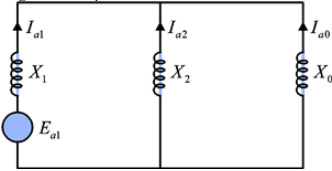
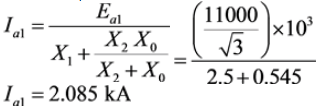
 [For current division rule]
[For current division rule]

X0 = 0.3X1 = 0.3 x 2.5 = 0.75 Ω
X2 = 0.8X1 = 0.7 x 2.5 = 2 Ω

Positive sequence current,

Zero sequence current,
 [For current division rule]
[For current division rule]
Current through ground is given by,

Hence, the current through ground is 4.549 kA.
Consider the state block diagram shown in figure, where x1 and x2 are state variable, ‘u’ represents input and ‘y’ is the output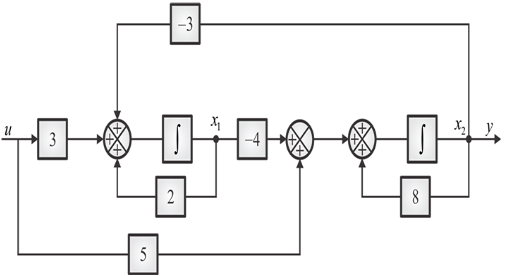 The given system is
The given system is- a)Not controllable but observable
- b)Not observable but controllable
- c)Neither observable nor controllable
- d)Both observable and controllable
Correct answer is option 'D'. Can you explain this answer?
Consider the state block diagram shown in figure, where x1 and x2 are state variable, ‘u’ represents input and ‘y’ is the output

The given system is
a)
Not controllable but observable
b)
Not observable but controllable
c)
Neither observable nor controllable
d)
Both observable and controllable

|
Cstoppers Instructors answered |
Given system is shown in figure below,



/
State equations can be written as

State space representation in matrix form is

To check controllability, controllability test matrix is

Similarly, observability test matrix is given as

In the circuit shown below, if Vs = 200 V, R1 = 10Ω, and R2 = 100Ω then the peak current through T2 is ___________ A. (Correct upto nearest integer)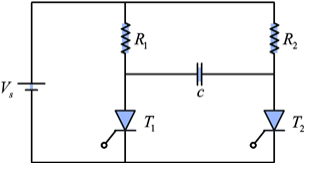
Correct answer is '42'. Can you explain this answer?
In the circuit shown below, if Vs = 200 V, R1 = 10Ω, and R2 = 100Ω then the peak current through T2 is ___________ A. (Correct upto nearest integer)


|
Pioneer Academy answered |
Given: Vs = 200 V, R1 = 10Ω, R2 = 100Ω
The peak value of current through thyristor is given by,

If prices reduce by 20% and sales increase by 15%, what is the net effect on gross receipts?- a)They increase by 8%.
- b)They decrease by 8%.
- c)They remain the same.
- d)They increase by 1.
Correct answer is option 'B'. Can you explain this answer?
If prices reduce by 20% and sales increase by 15%, what is the net effect on gross receipts?
a)
They increase by 8%.
b)
They decrease by 8%.
c)
They remain the same.
d)
They increase by 1.
|
|
Ayush Kumar answered |
Explanation:
To find the net effect on gross receipts, we need to consider the changes in prices and sales separately and then calculate the overall effect.
Effect of a 20% price reduction:
When the prices reduce by 20%, it means the new price will be 80% of the original price.
Let's assume the original price is 100 units. After the 20% reduction, the new price will be 80 units.
Effect of a 15% increase in sales:
To calculate the effect of a 15% increase in sales, we need to multiply the original sales by 1.15.
Let's assume the original sales are 100 units. After a 15% increase, the new sales will be 115 units.
Calculating the net effect on gross receipts:
To calculate the net effect on gross receipts, we need to multiply the new price by the new sales.
New Price = 80 units
New Sales = 115 units
Gross Receipts = New Price x New Sales
Gross Receipts = 80 units x 115 units
Gross Receipts = 9200 units
So, the net effect on gross receipts is a decrease of 8%, as the gross receipts decreased from 10000 units to 9200 units. Therefore, the correct answer is option B) They decrease by 8%.
To find the net effect on gross receipts, we need to consider the changes in prices and sales separately and then calculate the overall effect.
Effect of a 20% price reduction:
When the prices reduce by 20%, it means the new price will be 80% of the original price.
Let's assume the original price is 100 units. After the 20% reduction, the new price will be 80 units.
Effect of a 15% increase in sales:
To calculate the effect of a 15% increase in sales, we need to multiply the original sales by 1.15.
Let's assume the original sales are 100 units. After a 15% increase, the new sales will be 115 units.
Calculating the net effect on gross receipts:
To calculate the net effect on gross receipts, we need to multiply the new price by the new sales.
New Price = 80 units
New Sales = 115 units
Gross Receipts = New Price x New Sales
Gross Receipts = 80 units x 115 units
Gross Receipts = 9200 units
So, the net effect on gross receipts is a decrease of 8%, as the gross receipts decreased from 10000 units to 9200 units. Therefore, the correct answer is option B) They decrease by 8%.
For  if
if  and trace of A is 2 then value of y is
and trace of A is 2 then value of y is- a)1
- b)0
- c)-1
- d)2
Correct answer is option 'B'. Can you explain this answer?
For  if
if  and trace of A is 2 then value of y is
and trace of A is 2 then value of y is
 if
if  and trace of A is 2 then value of y is
and trace of A is 2 then value of y isa)
1
b)
0
c)
-1
d)
2
|
|
Yash Patel answered |

Trace = 2x = 2⇒x = 1
Put the value in equation (i),
1+y2 = 1
Y = 0
Two discrete time systems S1 and S2 are connected in cascade to form a new system as shown in figure below: Consider the following statements:a. If S1 and S2 are linear, then S is linear.b. If S1 and S2 are nonlinear, then S is nonlinear.c. If S1 and S2 are causal, then S is causal.d. If S1 and S2 are time invariant, then S is time invariant.True statements are
Consider the following statements:a. If S1 and S2 are linear, then S is linear.b. If S1 and S2 are nonlinear, then S is nonlinear.c. If S1 and S2 are causal, then S is causal.d. If S1 and S2 are time invariant, then S is time invariant.True statements are- a)a,b,c
- b)b,c,d
- c)a,c,d
- d)all
Correct answer is option 'C'. Can you explain this answer?
Two discrete time systems S1 and S2 are connected in cascade to form a new system as shown in figure below:

Consider the following statements:
a. If S1 and S2 are linear, then S is linear.
b. If S1 and S2 are nonlinear, then S is nonlinear.
c. If S1 and S2 are causal, then S is causal.
d. If S1 and S2 are time invariant, then S is time invariant.
True statements are
a)
a,b,c
b)
b,c,d
c)
a,c,d
d)
all

|
Pioneer Academy answered |

a. If S1 and S2 are linear, then S is linear.
c. If S1 and S2 are causal, then S is causal.
d. If S1 and S2 are time invariant, then S is time invariant.
a,c,d are the correct statements.
A 230/460 V transformer has a primary resistance of 0.2 Ω and reactance of 0.5 Ω and the corresponding values for the secondary are 0.75 Ω and 1.8 Ω respectively. The secondary voltage when supplying 10 A at 0.8 p.f. lagging is ___________ V.
Correct answer is '424.5'. Can you explain this answer?
A 230/460 V transformer has a primary resistance of 0.2 Ω and reactance of 0.5 Ω and the corresponding values for the secondary are 0.75 Ω and 1.8 Ω respectively. The secondary voltage when supplying 10 A at 0.8 p.f. lagging is ___________ V.
|
|
Abhay Khanna answered |
Given data:
Primary voltage, V1 = 230/460 V
Primary resistance, R1 = 0.2 Ω
Primary reactance, X1 = 0.5 Ω
Secondary resistance, R2 = 0.75 Ω
Secondary reactance, X2 = 1.8 Ω
Load current, I2 = 10 A
Power factor, pf = 0.8 lagging
To find: Secondary voltage, V2
Solution:
1. Find the equivalent impedance of the transformer referred to the primary side.
Zeq = [(R2 / S)² + (X2 / S - X1)²]^(1/2)
where S = V1 / V2 is the turns ratio
S = 460 / 230 = 2
Zeq = [(0.75 / 2)² + (1.8 / 2 - 0.5)²]^(1/2)
Zeq = 1.109 Ω
2. Find the apparent power, S2, and real power, P2, of the load.
S2 = V2 * I2
P2 = S2 * pf
We know that P2 = V2 * I2 * pf
Therefore, V2 = P2 / I2 / pf
V2 = S2 / pf
S2 = 230 * 10 * 0.8 = 1840 VA
P2 = S2 * 0.8 = 1472 W
V2 = 1840 / 0.8 / 10 = 230 V
3. Find the voltage drop in the transformer referred to the primary side.
V1 = V2 + I2 * Zeq
V2 = V1 - I2 * Zeq
V2 = 230 - 10 * 1.109
V2 = 219.91 V
4. Find the actual secondary voltage, taking into account the voltage drop.
V2 = V2' + I2 * R2
V2 = 219.91 + 10 * 0.75
V2 = 227.41 V
Therefore, the secondary voltage when supplying 10 A at 0.8 p.f. lagging is 424.5 V (rounded off to one decimal place).
Primary voltage, V1 = 230/460 V
Primary resistance, R1 = 0.2 Ω
Primary reactance, X1 = 0.5 Ω
Secondary resistance, R2 = 0.75 Ω
Secondary reactance, X2 = 1.8 Ω
Load current, I2 = 10 A
Power factor, pf = 0.8 lagging
To find: Secondary voltage, V2
Solution:
1. Find the equivalent impedance of the transformer referred to the primary side.
Zeq = [(R2 / S)² + (X2 / S - X1)²]^(1/2)
where S = V1 / V2 is the turns ratio
S = 460 / 230 = 2
Zeq = [(0.75 / 2)² + (1.8 / 2 - 0.5)²]^(1/2)
Zeq = 1.109 Ω
2. Find the apparent power, S2, and real power, P2, of the load.
S2 = V2 * I2
P2 = S2 * pf
We know that P2 = V2 * I2 * pf
Therefore, V2 = P2 / I2 / pf
V2 = S2 / pf
S2 = 230 * 10 * 0.8 = 1840 VA
P2 = S2 * 0.8 = 1472 W
V2 = 1840 / 0.8 / 10 = 230 V
3. Find the voltage drop in the transformer referred to the primary side.
V1 = V2 + I2 * Zeq
V2 = V1 - I2 * Zeq
V2 = 230 - 10 * 1.109
V2 = 219.91 V
4. Find the actual secondary voltage, taking into account the voltage drop.
V2 = V2' + I2 * R2
V2 = 219.91 + 10 * 0.75
V2 = 227.41 V
Therefore, the secondary voltage when supplying 10 A at 0.8 p.f. lagging is 424.5 V (rounded off to one decimal place).
Choose the most appropriate alternative from the options given below to complete the following question:The magnificent monument has now been restored _______ its original state.- a)to
- b)back to
- c)into
- d)No preposition required
Correct answer is option 'A'. Can you explain this answer?
Choose the most appropriate alternative from the options given below to complete the following question:
The magnificent monument has now been restored _______ its original state.
a)
to
b)
back to
c)
into
d)
No preposition required
|
|
Muskaan Nair answered |
Answer:
The correct answer is option 'A': "to".
Explanation:
When we say that something has been restored, it means that it has been brought back to its original condition or state. In this case, the magnificent monument has been restored to its original state.
Usage of preposition:
The preposition "to" is used to indicate the destination or result of an action. In this case, the restoration process has resulted in the monument being brought back to its original state. Therefore, the preposition "to" is the most appropriate choice to complete the sentence.
Other options:
- Option 'B': "back to" is not necessary because the word "restored" already implies the idea of going back to something.
- Option 'C': "into" is incorrect because it suggests a change in state or transformation, which is not the case here.
- Option 'D': "No preposition required" is incorrect because a preposition is required to indicate the result or destination of the restoration process.
Example sentence:
The magnificent monument has now been restored to its original state, showcasing its true grandeur and beauty.
The correct answer is option 'A': "to".
Explanation:
When we say that something has been restored, it means that it has been brought back to its original condition or state. In this case, the magnificent monument has been restored to its original state.
Usage of preposition:
The preposition "to" is used to indicate the destination or result of an action. In this case, the restoration process has resulted in the monument being brought back to its original state. Therefore, the preposition "to" is the most appropriate choice to complete the sentence.
Other options:
- Option 'B': "back to" is not necessary because the word "restored" already implies the idea of going back to something.
- Option 'C': "into" is incorrect because it suggests a change in state or transformation, which is not the case here.
- Option 'D': "No preposition required" is incorrect because a preposition is required to indicate the result or destination of the restoration process.
Example sentence:
The magnificent monument has now been restored to its original state, showcasing its true grandeur and beauty.
Consider the circuit shown in figure below. If β of the transistor is large then the value of the stabilization factor (s) for the given circuit will be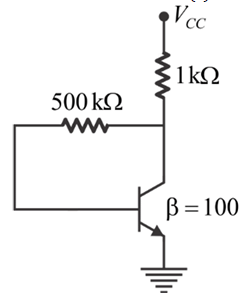
- a)48
- b)24
- c)84
- d)Insufficient data
Correct answer is option 'C'. Can you explain this answer?
Consider the circuit shown in figure below. If β of the transistor is large then the value of the stabilization factor (s) for the given circuit will be

a)
48
b)
24
c)
84
d)
Insufficient data

|
Cstoppers Instructors answered |
Given circuit is a collector to base biased circuit for which the stabilization factor is given as

Directions: The following verbal analogy has two parts. One part is complete while the other one is incomplete. Complete the portion that is incomplete by selecting the right choice from the given options.Son : Nuclear : : ______ : Extended- a)Father
- b)Mother
- c)Cousin
- d)Daughters
Correct answer is option 'C'. Can you explain this answer?
Directions: The following verbal analogy has two parts. One part is complete while the other one is incomplete. Complete the portion that is incomplete by selecting the right choice from the given options.
Son : Nuclear : : ______ : Extended
a)
Father
b)
Mother
c)
Cousin
d)
Daughters
|
|
Kiran Iyer answered |
Solution:
The given verbal analogy is:
Son : Nuclear :: ______ : Extended
To solve this analogy, we need to understand the relationship between the terms in the first part and find a similar relationship in the second part.
Analysis:
The term "Son" is related to "Nuclear" in the sense that a son is a part of a nuclear family. In a nuclear family, there is a father, a mother, and their children. So, "Son" is a member of the "Nuclear" family.
To complete the analogy, we need to find a term that is a member of an "Extended" family.
Options:
a) Father: A father is a member of a nuclear family, not an extended family. Therefore, option a) is incorrect.
b) Mother: Similar to option a), a mother is also a member of a nuclear family, not an extended family. Therefore, option b) is incorrect.
c) Cousin: A cousin is a member of an extended family. When relatives beyond the immediate family are considered, cousins are included. Therefore, option c) is correct.
d) Daughters: Daughters are also members of a nuclear family. They are part of the immediate family, not the extended family. Therefore, option d) is incorrect.
Conclusion:
The correct answer is option c) Cousin. A cousin is a member of an extended family, similar to how a son is a member of a nuclear family.
The given verbal analogy is:
Son : Nuclear :: ______ : Extended
To solve this analogy, we need to understand the relationship between the terms in the first part and find a similar relationship in the second part.
Analysis:
The term "Son" is related to "Nuclear" in the sense that a son is a part of a nuclear family. In a nuclear family, there is a father, a mother, and their children. So, "Son" is a member of the "Nuclear" family.
To complete the analogy, we need to find a term that is a member of an "Extended" family.
Options:
a) Father: A father is a member of a nuclear family, not an extended family. Therefore, option a) is incorrect.
b) Mother: Similar to option a), a mother is also a member of a nuclear family, not an extended family. Therefore, option b) is incorrect.
c) Cousin: A cousin is a member of an extended family. When relatives beyond the immediate family are considered, cousins are included. Therefore, option c) is correct.
d) Daughters: Daughters are also members of a nuclear family. They are part of the immediate family, not the extended family. Therefore, option d) is incorrect.
Conclusion:
The correct answer is option c) Cousin. A cousin is a member of an extended family, similar to how a son is a member of a nuclear family.
A voltage commutation circuit is shown in figure. The turn-off time of the both SCR is 60 sec and current through R1 and R2 is 20 A and voltage is 120 V. What will be the minimum value of capacitor (in μF) required for proper commutation? (Answer up to one decimal place)
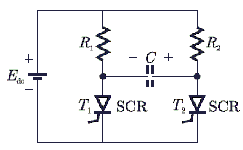 Correct answer is '14.4'. Can you explain this answer?
Correct answer is '14.4'. Can you explain this answer?
A voltage commutation circuit is shown in figure. The turn-off time of the both SCR is 60 sec and current through R1 and R2 is 20 A and voltage is 120 V. What will be the minimum value of capacitor (in μF) required for proper commutation? (Answer up to one decimal place)

|
|
Pooja Patel answered |

A 500 MVA, 22 kV, 60 Hz four pole turbo generator has an inertia constant of H=7.5 MJ/MVA. If the mechanical power input is 552 MW and the electrical power output is 400 MW and stator copper loss is assumed to be negligible, then the angular acceleration is _______ rpm/sec2. (rounded upto two decimal places)
Correct answer is '36.48'. Can you explain this answer?
A 500 MVA, 22 kV, 60 Hz four pole turbo generator has an inertia constant of H=7.5 MJ/MVA. If the mechanical power input is 552 MW and the electrical power output is 400 MW and stator copper loss is assumed to be negligible, then the angular acceleration is _______ rpm/sec2. (rounded upto two decimal places)
|
|
Aarya Basu answered |
Solution:
Given data:
MVA rating of the generator (S) = 500 MVA
Voltage rating (V) = 22 kV
Frequency (f) = 60 Hz
Inertia constant (H) = 7.5 MJ/MVA
Mechanical power input (Pm) = 552 MW
Electrical power output (Pe) = 400 MW
We know that the mechanical power input to the generator is converted into electrical power output and losses. Therefore,
Pm = Pe + losses
In this case, we assume that stator copper losses are negligible. Therefore,
Pm = Pe + mechanical losses
Mechanical losses include friction and windage losses, which are assumed to be constant for the given conditions. Hence, we can write,
Pm = Pe + constant losses
or, constant losses = Pm - Pe = 152 MW
Now, we can find the torque developed by the generator using the formula,
T = Pe / (ωe)
where ωe is the electrical angular velocity. We know that,
f = ωe / (2π)
or, ωe = 2πf = 377 rad/s
Therefore,
T = Pe / ωe = 400 MW / 377 rad/s = 1.06 MNm
The angular acceleration of the generator can be found using the formula,
ω = (T - Dω) / (H S)
where D is the damping coefficient, which is assumed to be zero for this case.
Therefore,
ω = T / (H S) = 1.06 MNm / (7.5 MJ/MVA x 500 MVA) = 0.00028 rad/s2
The angular acceleration in rpm/sec2 can be found using the conversion factor,
1 rpm = 2π/60 rad/s
Therefore,
ω = 0.00028 x 60 / 2π = 0.0168 rpm/s2
Finally, rounding off to two decimal places, we get the answer as,
Angular acceleration = 0.0168 rpm/s2 ≈ 36.48 rpm/sec2.
Hence, the answer is 36.48 rpm/sec2.
Given data:
MVA rating of the generator (S) = 500 MVA
Voltage rating (V) = 22 kV
Frequency (f) = 60 Hz
Inertia constant (H) = 7.5 MJ/MVA
Mechanical power input (Pm) = 552 MW
Electrical power output (Pe) = 400 MW
We know that the mechanical power input to the generator is converted into electrical power output and losses. Therefore,
Pm = Pe + losses
In this case, we assume that stator copper losses are negligible. Therefore,
Pm = Pe + mechanical losses
Mechanical losses include friction and windage losses, which are assumed to be constant for the given conditions. Hence, we can write,
Pm = Pe + constant losses
or, constant losses = Pm - Pe = 152 MW
Now, we can find the torque developed by the generator using the formula,
T = Pe / (ωe)
where ωe is the electrical angular velocity. We know that,
f = ωe / (2π)
or, ωe = 2πf = 377 rad/s
Therefore,
T = Pe / ωe = 400 MW / 377 rad/s = 1.06 MNm
The angular acceleration of the generator can be found using the formula,
ω = (T - Dω) / (H S)
where D is the damping coefficient, which is assumed to be zero for this case.
Therefore,
ω = T / (H S) = 1.06 MNm / (7.5 MJ/MVA x 500 MVA) = 0.00028 rad/s2
The angular acceleration in rpm/sec2 can be found using the conversion factor,
1 rpm = 2π/60 rad/s
Therefore,
ω = 0.00028 x 60 / 2π = 0.0168 rpm/s2
Finally, rounding off to two decimal places, we get the answer as,
Angular acceleration = 0.0168 rpm/s2 ≈ 36.48 rpm/sec2.
Hence, the answer is 36.48 rpm/sec2.
For how many of the given years in the below period total production of the company was more than the average production of the company during 2005-2010?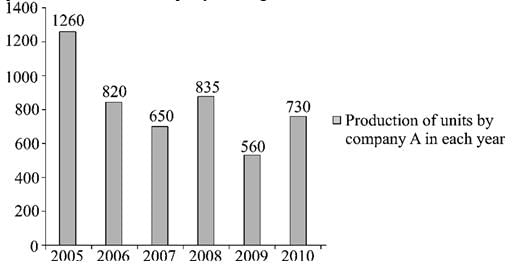
- a)4
- b)2
- c)3
- d)1
Correct answer is option 'C'. Can you explain this answer?
For how many of the given years in the below period total production of the company was more than the average production of the company during 2005-2010?

a)
4
b)
2
c)
3
d)
1
|
|
Ravi Singh answered |
Average production during the period 2005-2010

Hence, year which have production more than average production are 2005, 2006 and 2008.
Hence, the correct option is (C).
Chapter doubts & questions for Schedule & Syllabus - GATE Electrical Engineering (EE) Mock Test Series 2026 2025 is part of Electrical Engineering (EE) exam preparation. The chapters have been prepared according to the Electrical Engineering (EE) exam syllabus. The Chapter doubts & questions, notes, tests & MCQs are made for Electrical Engineering (EE) 2025 Exam. Find important definitions, questions, notes, meanings, examples, exercises, MCQs and online tests here.
Chapter doubts & questions of Schedule & Syllabus - GATE Electrical Engineering (EE) Mock Test Series 2026 in English & Hindi are available as part of Electrical Engineering (EE) exam.
Download more important topics, notes, lectures and mock test series for Electrical Engineering (EE) Exam by signing up for free.
GATE Electrical Engineering (EE) Mock Test Series 2026
26 docs|257 tests
|

Contact Support
Our team is online on weekdays between 10 AM - 7 PM
Typical reply within 3 hours
|
Free Exam Preparation
at your Fingertips!
Access Free Study Material - Test Series, Structured Courses, Free Videos & Study Notes and Prepare for Your Exam With Ease

 Join the 10M+ students on EduRev
Join the 10M+ students on EduRev
|

|
Create your account for free
OR
Forgot Password
OR
Signup to see your scores
go up
within 7 days!
within 7 days!
Takes less than 10 seconds to signup

 The energy of the signal is
The energy of the signal is






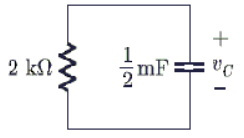


 then in order that AB = 0, the values of x and y will be respectively
then in order that AB = 0, the values of x and y will be respectively